Implementing and Monitoring Work Health and Safety Practices Analysis
VerifiedAdded on 2023/06/04
|27
|3912
|216
Homework Assignment
AI Summary
This assignment solution provides a detailed overview of implementing and monitoring work health and safety (WHS) practices. It addresses key aspects such as consulting with workers, providing workplace safety information, emergency evacuation plans, and monitoring WHS procedures. The solution also covers documenting WHS compliance, addressing non-compliance, and identifying potential hazards. It further explores consultation arrangements, methods for staff contribution, and referral pathways for unresolved issues. The importance of communicating results to staff, risk management instances, and different types of WHS training methods are also discussed. The solution highlights the significance of Safety Data Sheets (SDS), risk assessment documents, and training records. It also touches on minimizing environmental impacts, employer's duty of care, and the role of WHS committees. The second assessment involves selecting and analyzing specific situations related to WHS, such as evacuation procedures, security management, and handling hazardous substances, referencing relevant codes of practice and legislation from Safe Work Australia. This assignment is available on Desklib, where students can find a wealth of academic resources including past papers and solved assignments.
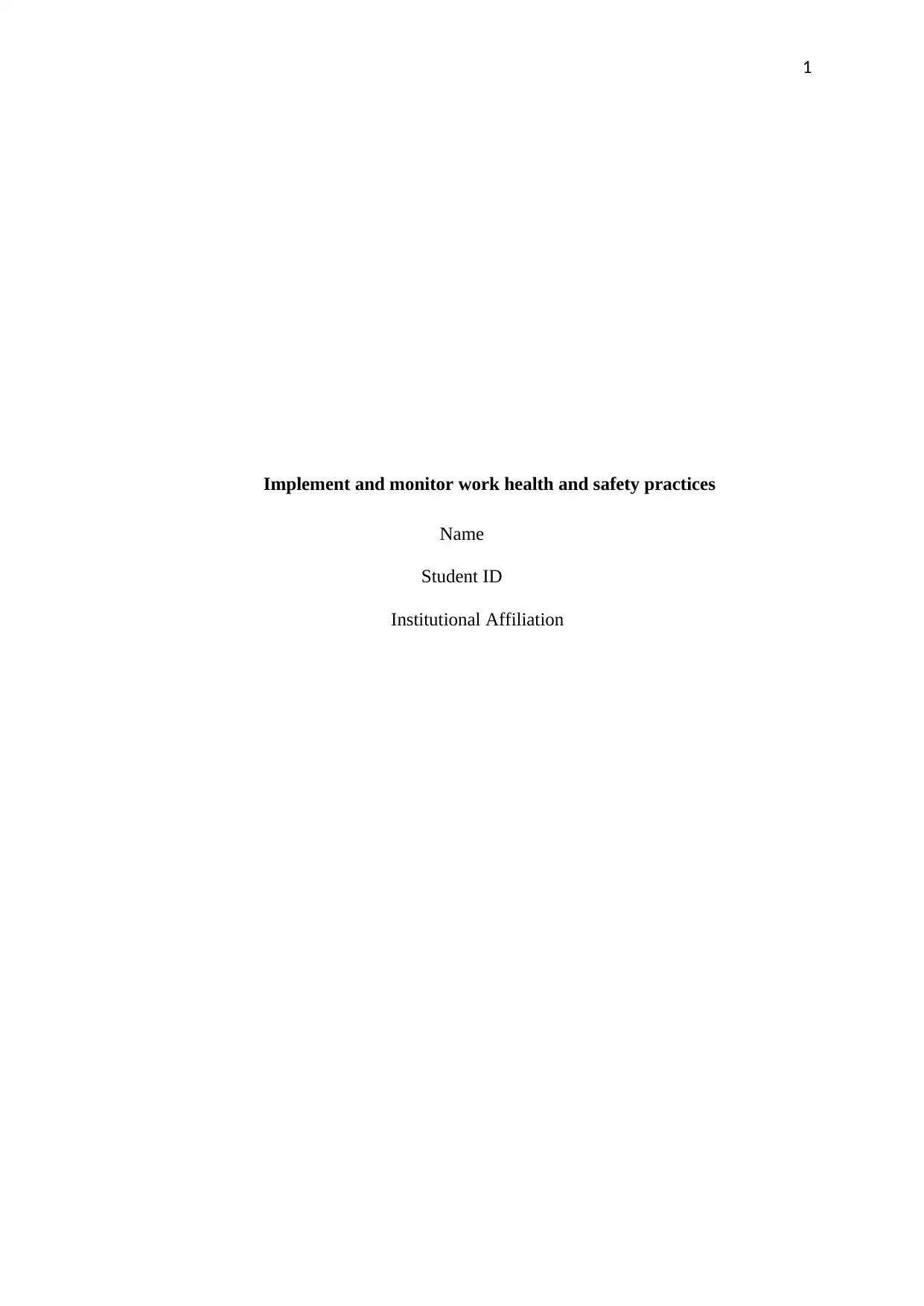
1
Implement and monitor work health and safety practices
Name
Student ID
Institutional Affiliation
Implement and monitor work health and safety practices
Name
Student ID
Institutional Affiliation
Paraphrase This Document
Need a fresh take? Get an instant paraphrase of this document with our AI Paraphraser
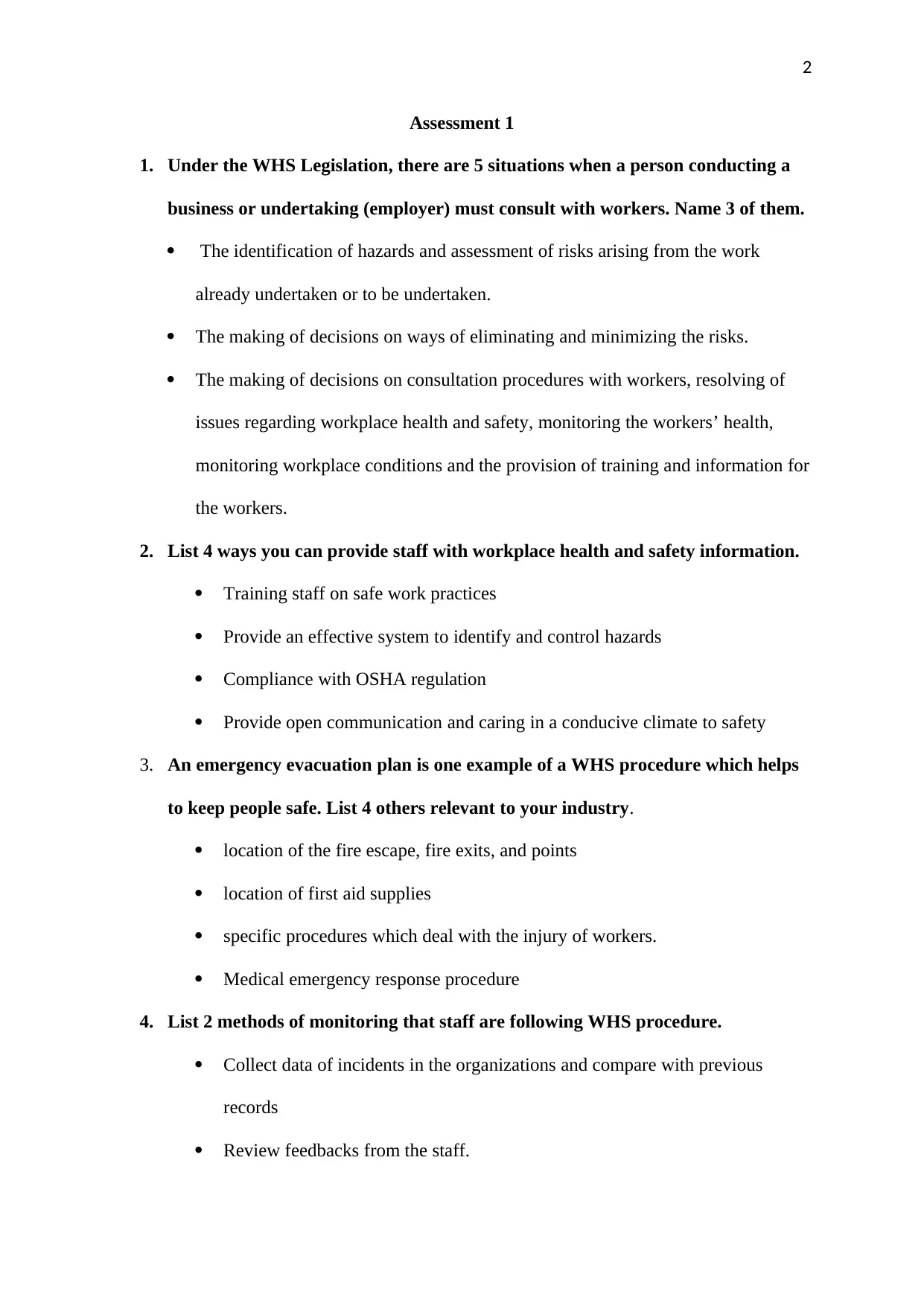
2
Assessment 1
1. Under the WHS Legislation, there are 5 situations when a person conducting a
business or undertaking (employer) must consult with workers. Name 3 of them.
The identification of hazards and assessment of risks arising from the work
already undertaken or to be undertaken.
The making of decisions on ways of eliminating and minimizing the risks.
The making of decisions on consultation procedures with workers, resolving of
issues regarding workplace health and safety, monitoring the workers’ health,
monitoring workplace conditions and the provision of training and information for
the workers.
2. List 4 ways you can provide staff with workplace health and safety information.
Training staff on safe work practices
Provide an effective system to identify and control hazards
Compliance with OSHA regulation
Provide open communication and caring in a conducive climate to safety
3. An emergency evacuation plan is one example of a WHS procedure which helps
to keep people safe. List 4 others relevant to your industry.
location of the fire escape, fire exits, and points
location of first aid supplies
specific procedures which deal with the injury of workers.
Medical emergency response procedure
4. List 2 methods of monitoring that staff are following WHS procedure.
Collect data of incidents in the organizations and compare with previous
records
Review feedbacks from the staff.
Assessment 1
1. Under the WHS Legislation, there are 5 situations when a person conducting a
business or undertaking (employer) must consult with workers. Name 3 of them.
The identification of hazards and assessment of risks arising from the work
already undertaken or to be undertaken.
The making of decisions on ways of eliminating and minimizing the risks.
The making of decisions on consultation procedures with workers, resolving of
issues regarding workplace health and safety, monitoring the workers’ health,
monitoring workplace conditions and the provision of training and information for
the workers.
2. List 4 ways you can provide staff with workplace health and safety information.
Training staff on safe work practices
Provide an effective system to identify and control hazards
Compliance with OSHA regulation
Provide open communication and caring in a conducive climate to safety
3. An emergency evacuation plan is one example of a WHS procedure which helps
to keep people safe. List 4 others relevant to your industry.
location of the fire escape, fire exits, and points
location of first aid supplies
specific procedures which deal with the injury of workers.
Medical emergency response procedure
4. List 2 methods of monitoring that staff are following WHS procedure.
Collect data of incidents in the organizations and compare with previous
records
Review feedbacks from the staff.
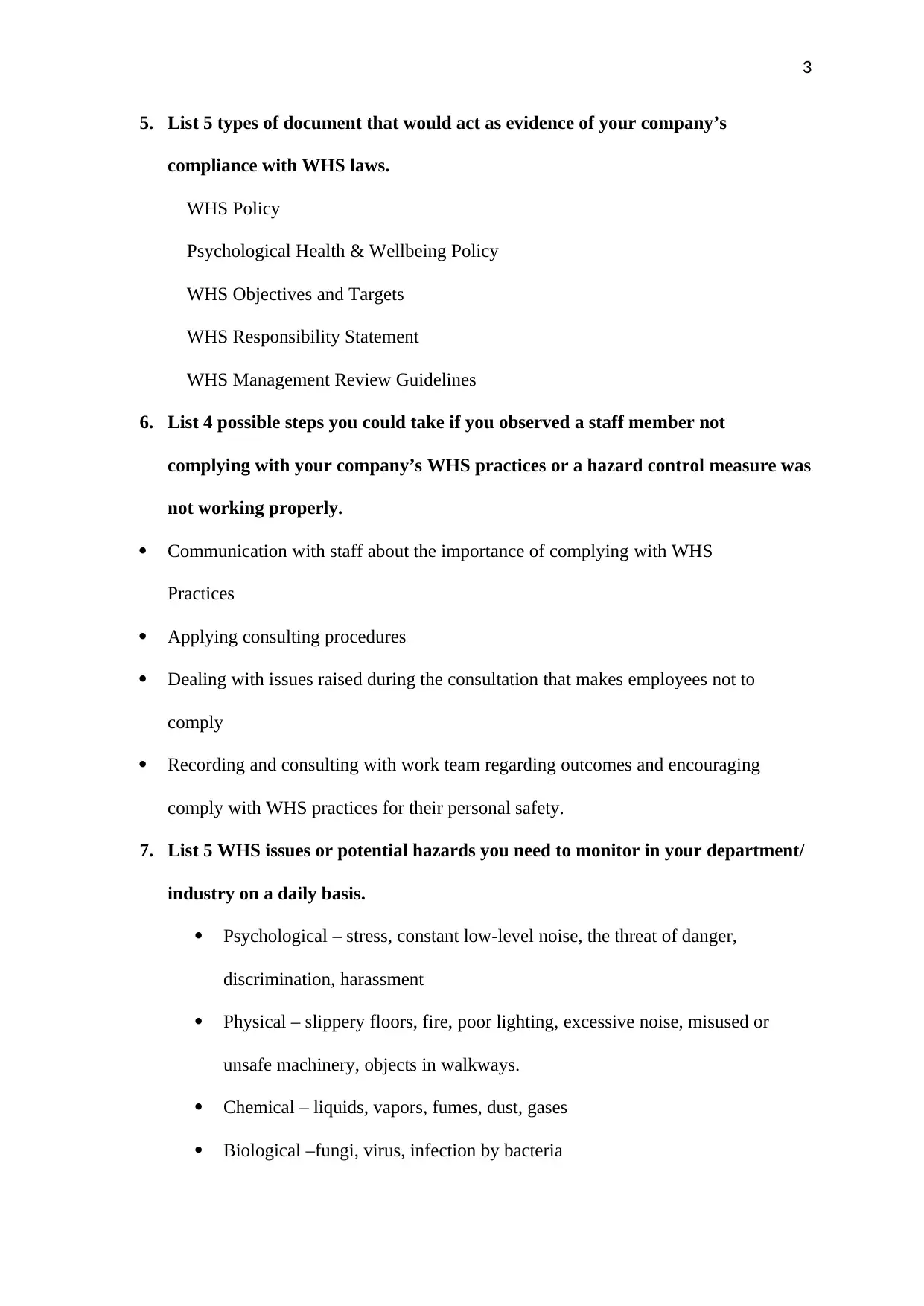
3
5. List 5 types of document that would act as evidence of your company’s
compliance with WHS laws.
WHS Policy
Psychological Health & Wellbeing Policy
WHS Objectives and Targets
WHS Responsibility Statement
WHS Management Review Guidelines
6. List 4 possible steps you could take if you observed a staff member not
complying with your company’s WHS practices or a hazard control measure was
not working properly.
Communication with staff about the importance of complying with WHS
Practices
Applying consulting procedures
Dealing with issues raised during the consultation that makes employees not to
comply
Recording and consulting with work team regarding outcomes and encouraging
comply with WHS practices for their personal safety.
7. List 5 WHS issues or potential hazards you need to monitor in your department/
industry on a daily basis.
Psychological – stress, constant low-level noise, the threat of danger,
discrimination, harassment
Physical – slippery floors, fire, poor lighting, excessive noise, misused or
unsafe machinery, objects in walkways.
Chemical – liquids, vapors, fumes, dust, gases
Biological –fungi, virus, infection by bacteria
5. List 5 types of document that would act as evidence of your company’s
compliance with WHS laws.
WHS Policy
Psychological Health & Wellbeing Policy
WHS Objectives and Targets
WHS Responsibility Statement
WHS Management Review Guidelines
6. List 4 possible steps you could take if you observed a staff member not
complying with your company’s WHS practices or a hazard control measure was
not working properly.
Communication with staff about the importance of complying with WHS
Practices
Applying consulting procedures
Dealing with issues raised during the consultation that makes employees not to
comply
Recording and consulting with work team regarding outcomes and encouraging
comply with WHS practices for their personal safety.
7. List 5 WHS issues or potential hazards you need to monitor in your department/
industry on a daily basis.
Psychological – stress, constant low-level noise, the threat of danger,
discrimination, harassment
Physical – slippery floors, fire, poor lighting, excessive noise, misused or
unsafe machinery, objects in walkways.
Chemical – liquids, vapors, fumes, dust, gases
Biological –fungi, virus, infection by bacteria
⊘ This is a preview!⊘
Do you want full access?
Subscribe today to unlock all pages.

Trusted by 1+ million students worldwide
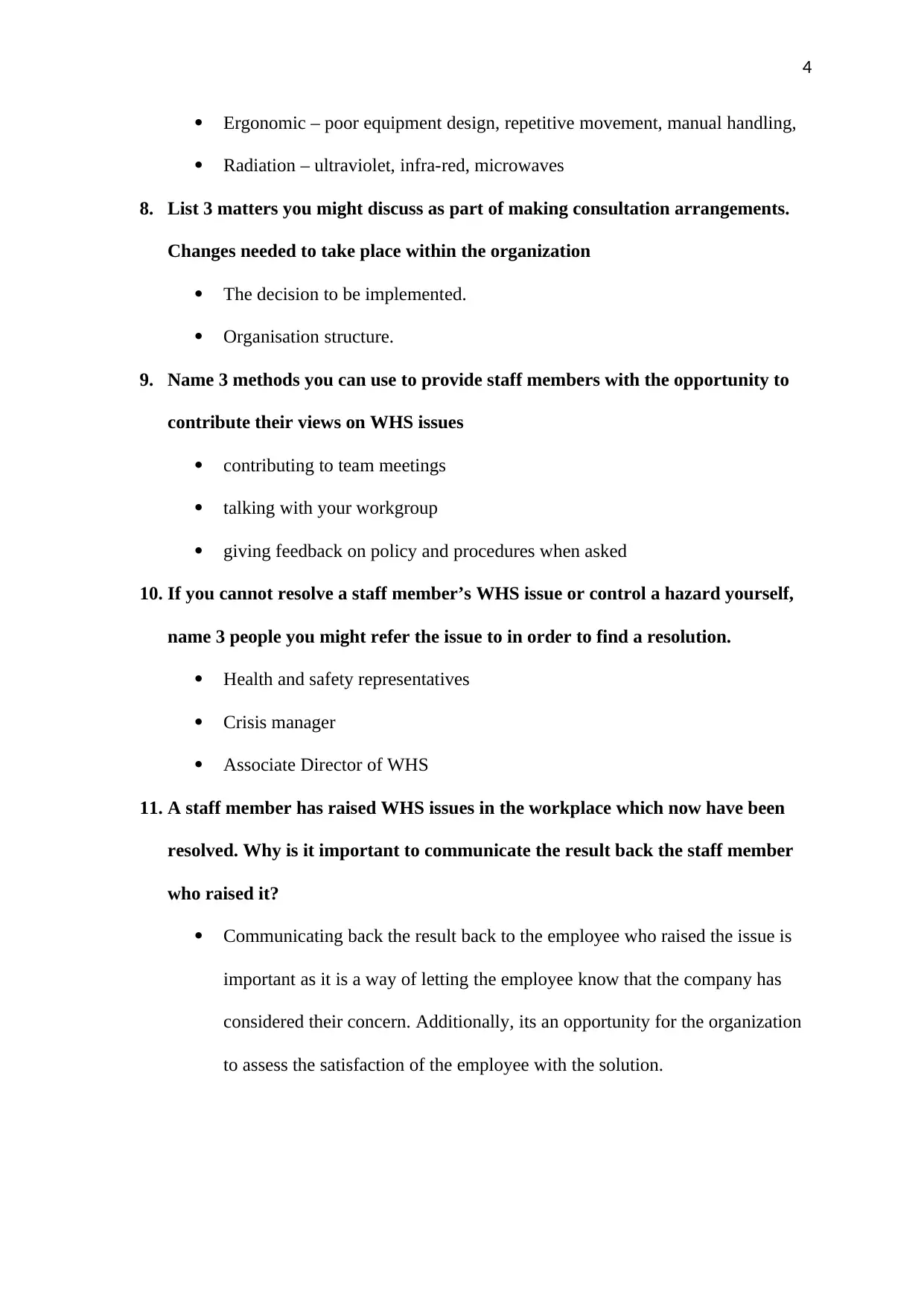
4
Ergonomic – poor equipment design, repetitive movement, manual handling,
Radiation – ultraviolet, infra-red, microwaves
8. List 3 matters you might discuss as part of making consultation arrangements.
Changes needed to take place within the organization
The decision to be implemented.
Organisation structure.
9. Name 3 methods you can use to provide staff members with the opportunity to
contribute their views on WHS issues
contributing to team meetings
talking with your workgroup
giving feedback on policy and procedures when asked
10. If you cannot resolve a staff member’s WHS issue or control a hazard yourself,
name 3 people you might refer the issue to in order to find a resolution.
Health and safety representatives
Crisis manager
Associate Director of WHS
11. A staff member has raised WHS issues in the workplace which now have been
resolved. Why is it important to communicate the result back the staff member
who raised it?
Communicating back the result back to the employee who raised the issue is
important as it is a way of letting the employee know that the company has
considered their concern. Additionally, its an opportunity for the organization
to assess the satisfaction of the employee with the solution.
Ergonomic – poor equipment design, repetitive movement, manual handling,
Radiation – ultraviolet, infra-red, microwaves
8. List 3 matters you might discuss as part of making consultation arrangements.
Changes needed to take place within the organization
The decision to be implemented.
Organisation structure.
9. Name 3 methods you can use to provide staff members with the opportunity to
contribute their views on WHS issues
contributing to team meetings
talking with your workgroup
giving feedback on policy and procedures when asked
10. If you cannot resolve a staff member’s WHS issue or control a hazard yourself,
name 3 people you might refer the issue to in order to find a resolution.
Health and safety representatives
Crisis manager
Associate Director of WHS
11. A staff member has raised WHS issues in the workplace which now have been
resolved. Why is it important to communicate the result back the staff member
who raised it?
Communicating back the result back to the employee who raised the issue is
important as it is a way of letting the employee know that the company has
considered their concern. Additionally, its an opportunity for the organization
to assess the satisfaction of the employee with the solution.
Paraphrase This Document
Need a fresh take? Get an instant paraphrase of this document with our AI Paraphraser
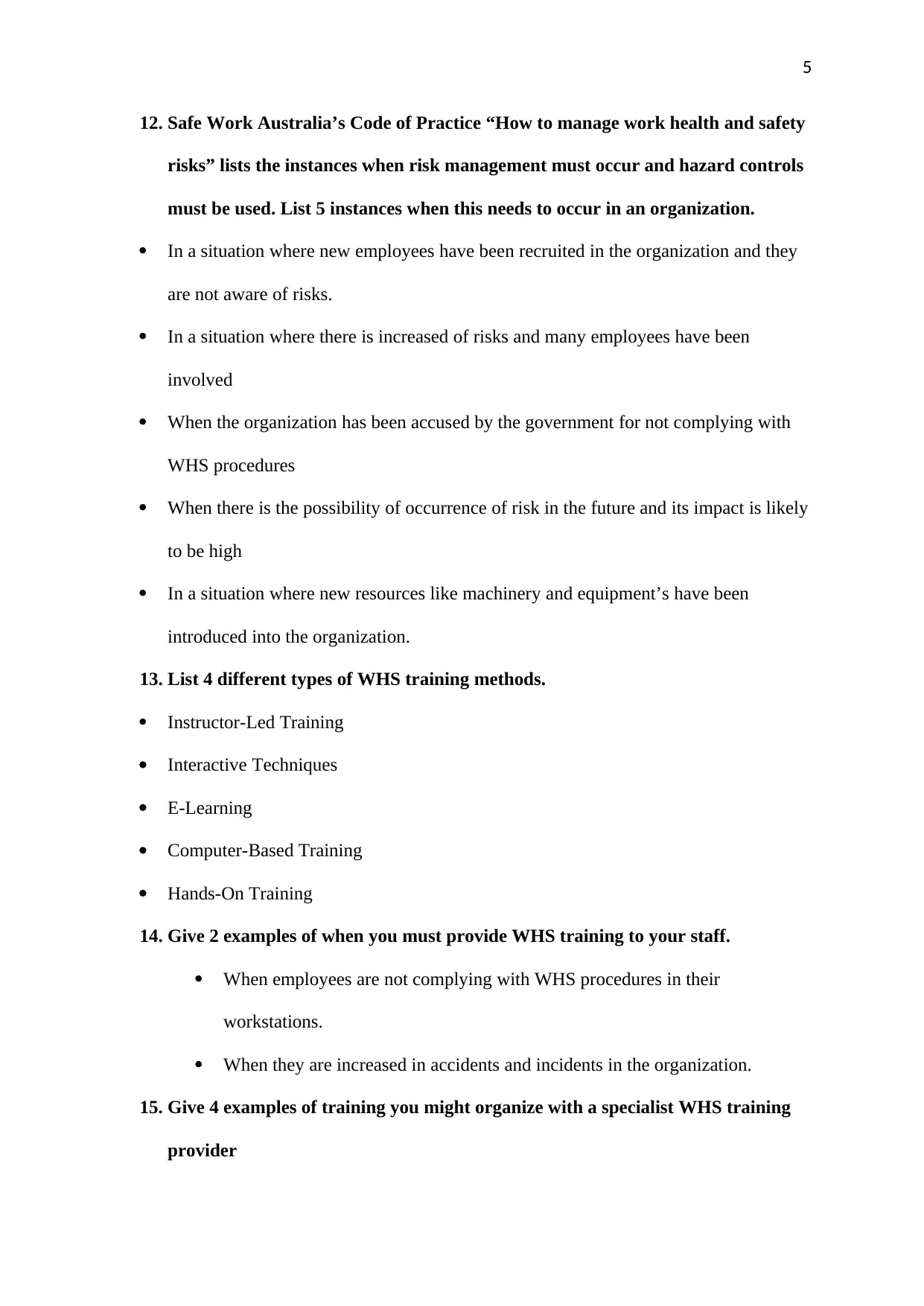
5
12. Safe Work Australia’s Code of Practice “How to manage work health and safety
risks” lists the instances when risk management must occur and hazard controls
must be used. List 5 instances when this needs to occur in an organization.
In a situation where new employees have been recruited in the organization and they
are not aware of risks.
In a situation where there is increased of risks and many employees have been
involved
When the organization has been accused by the government for not complying with
WHS procedures
When there is the possibility of occurrence of risk in the future and its impact is likely
to be high
In a situation where new resources like machinery and equipment’s have been
introduced into the organization.
13. List 4 different types of WHS training methods.
Instructor-Led Training
Interactive Techniques
E-Learning
Computer-Based Training
Hands-On Training
14. Give 2 examples of when you must provide WHS training to your staff.
When employees are not complying with WHS procedures in their
workstations.
When they are increased in accidents and incidents in the organization.
15. Give 4 examples of training you might organize with a specialist WHS training
provider
12. Safe Work Australia’s Code of Practice “How to manage work health and safety
risks” lists the instances when risk management must occur and hazard controls
must be used. List 5 instances when this needs to occur in an organization.
In a situation where new employees have been recruited in the organization and they
are not aware of risks.
In a situation where there is increased of risks and many employees have been
involved
When the organization has been accused by the government for not complying with
WHS procedures
When there is the possibility of occurrence of risk in the future and its impact is likely
to be high
In a situation where new resources like machinery and equipment’s have been
introduced into the organization.
13. List 4 different types of WHS training methods.
Instructor-Led Training
Interactive Techniques
E-Learning
Computer-Based Training
Hands-On Training
14. Give 2 examples of when you must provide WHS training to your staff.
When employees are not complying with WHS procedures in their
workstations.
When they are increased in accidents and incidents in the organization.
15. Give 4 examples of training you might organize with a specialist WHS training
provider
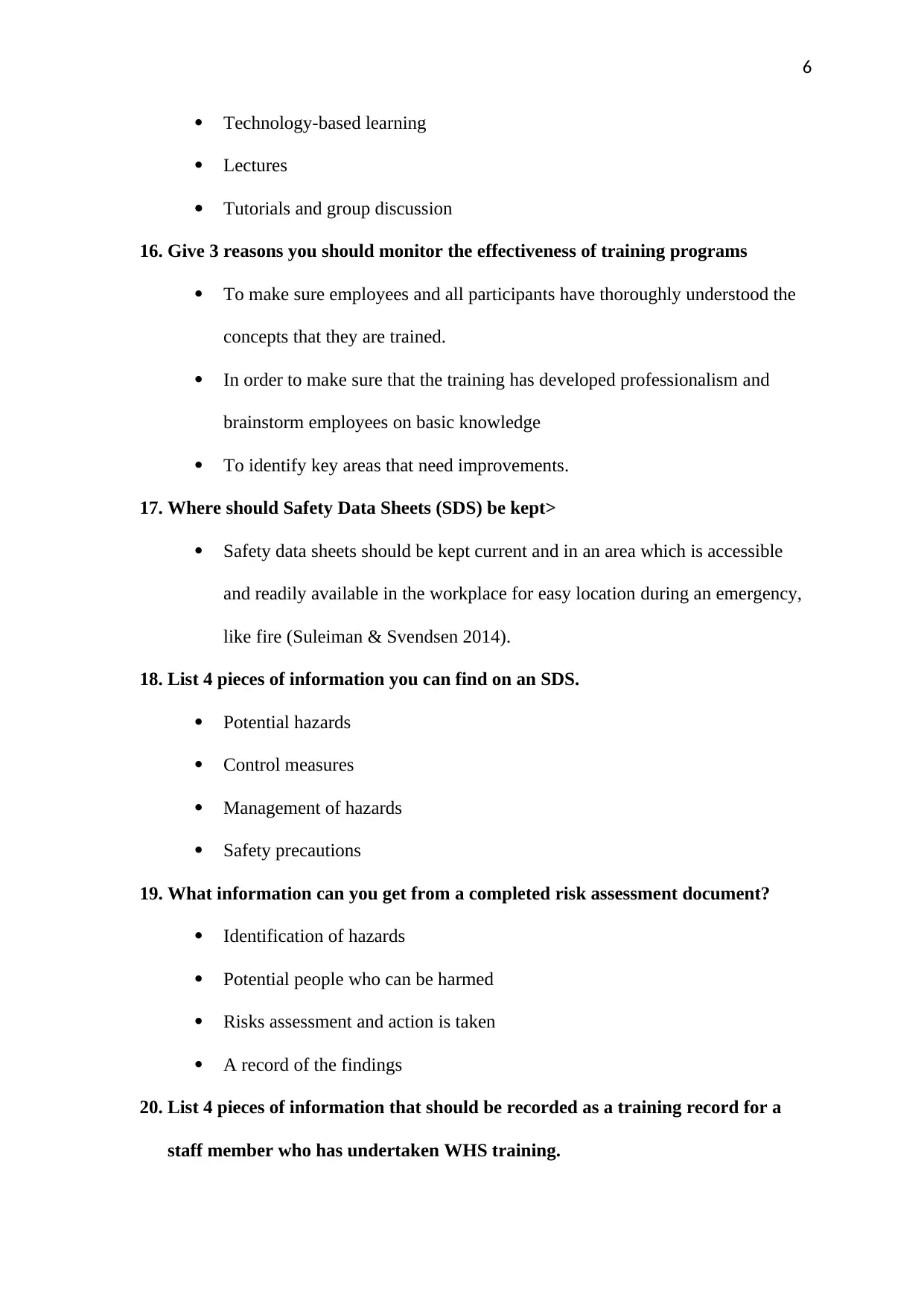
6
Technology-based learning
Lectures
Tutorials and group discussion
16. Give 3 reasons you should monitor the effectiveness of training programs
To make sure employees and all participants have thoroughly understood the
concepts that they are trained.
In order to make sure that the training has developed professionalism and
brainstorm employees on basic knowledge
To identify key areas that need improvements.
17. Where should Safety Data Sheets (SDS) be kept>
Safety data sheets should be kept current and in an area which is accessible
and readily available in the workplace for easy location during an emergency,
like fire (Suleiman & Svendsen 2014).
18. List 4 pieces of information you can find on an SDS.
Potential hazards
Control measures
Management of hazards
Safety precautions
19. What information can you get from a completed risk assessment document?
Identification of hazards
Potential people who can be harmed
Risks assessment and action is taken
A record of the findings
20. List 4 pieces of information that should be recorded as a training record for a
staff member who has undertaken WHS training.
Technology-based learning
Lectures
Tutorials and group discussion
16. Give 3 reasons you should monitor the effectiveness of training programs
To make sure employees and all participants have thoroughly understood the
concepts that they are trained.
In order to make sure that the training has developed professionalism and
brainstorm employees on basic knowledge
To identify key areas that need improvements.
17. Where should Safety Data Sheets (SDS) be kept>
Safety data sheets should be kept current and in an area which is accessible
and readily available in the workplace for easy location during an emergency,
like fire (Suleiman & Svendsen 2014).
18. List 4 pieces of information you can find on an SDS.
Potential hazards
Control measures
Management of hazards
Safety precautions
19. What information can you get from a completed risk assessment document?
Identification of hazards
Potential people who can be harmed
Risks assessment and action is taken
A record of the findings
20. List 4 pieces of information that should be recorded as a training record for a
staff member who has undertaken WHS training.
⊘ This is a preview!⊘
Do you want full access?
Subscribe today to unlock all pages.

Trusted by 1+ million students worldwide
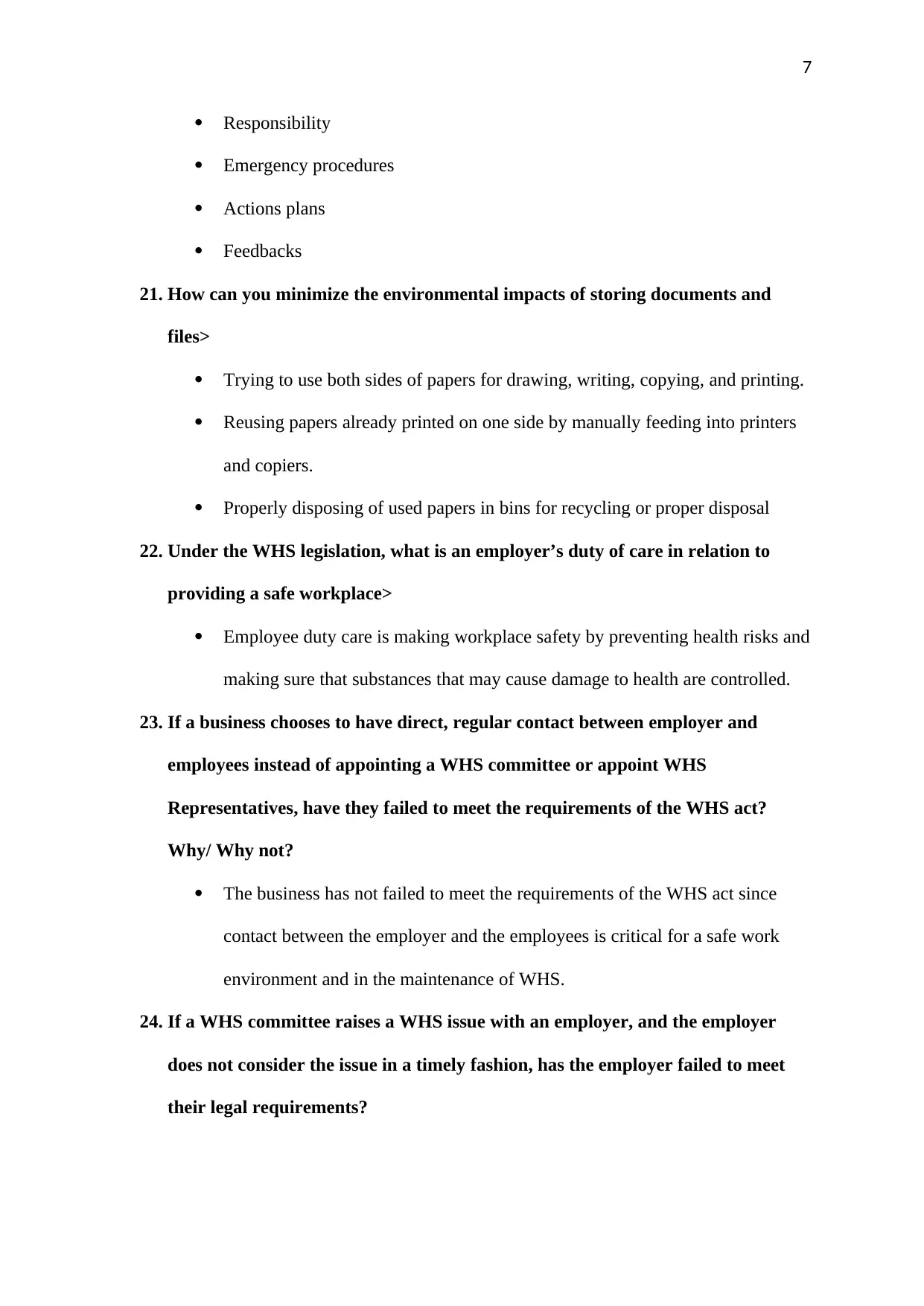
7
Responsibility
Emergency procedures
Actions plans
Feedbacks
21. How can you minimize the environmental impacts of storing documents and
files>
Trying to use both sides of papers for drawing, writing, copying, and printing.
Reusing papers already printed on one side by manually feeding into printers
and copiers.
Properly disposing of used papers in bins for recycling or proper disposal
22. Under the WHS legislation, what is an employer’s duty of care in relation to
providing a safe workplace>
Employee duty care is making workplace safety by preventing health risks and
making sure that substances that may cause damage to health are controlled.
23. If a business chooses to have direct, regular contact between employer and
employees instead of appointing a WHS committee or appoint WHS
Representatives, have they failed to meet the requirements of the WHS act?
Why/ Why not?
The business has not failed to meet the requirements of the WHS act since
contact between the employer and the employees is critical for a safe work
environment and in the maintenance of WHS.
24. If a WHS committee raises a WHS issue with an employer, and the employer
does not consider the issue in a timely fashion, has the employer failed to meet
their legal requirements?
Responsibility
Emergency procedures
Actions plans
Feedbacks
21. How can you minimize the environmental impacts of storing documents and
files>
Trying to use both sides of papers for drawing, writing, copying, and printing.
Reusing papers already printed on one side by manually feeding into printers
and copiers.
Properly disposing of used papers in bins for recycling or proper disposal
22. Under the WHS legislation, what is an employer’s duty of care in relation to
providing a safe workplace>
Employee duty care is making workplace safety by preventing health risks and
making sure that substances that may cause damage to health are controlled.
23. If a business chooses to have direct, regular contact between employer and
employees instead of appointing a WHS committee or appoint WHS
Representatives, have they failed to meet the requirements of the WHS act?
Why/ Why not?
The business has not failed to meet the requirements of the WHS act since
contact between the employer and the employees is critical for a safe work
environment and in the maintenance of WHS.
24. If a WHS committee raises a WHS issue with an employer, and the employer
does not consider the issue in a timely fashion, has the employer failed to meet
their legal requirements?
Paraphrase This Document
Need a fresh take? Get an instant paraphrase of this document with our AI Paraphraser
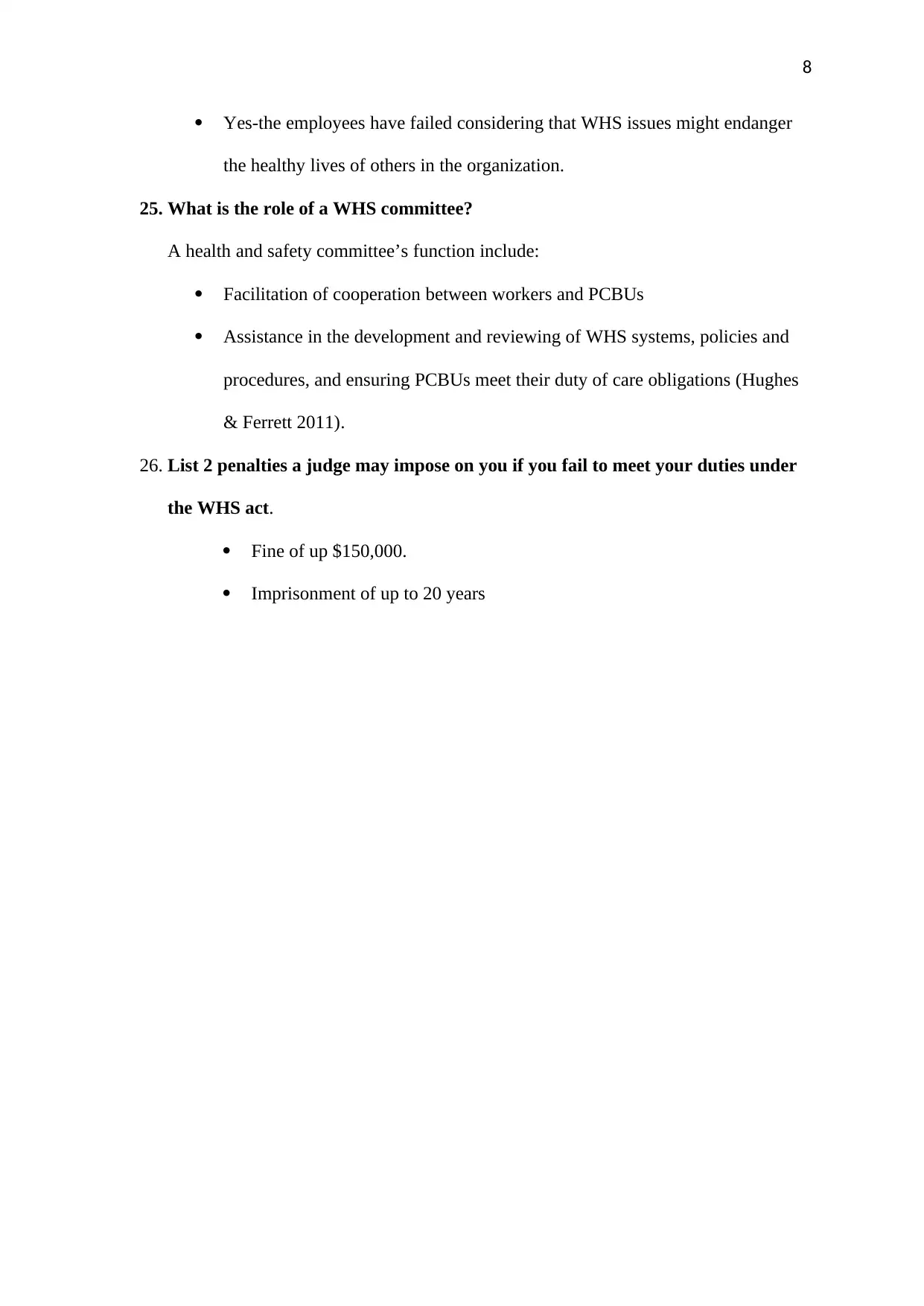
8
Yes-the employees have failed considering that WHS issues might endanger
the healthy lives of others in the organization.
25. What is the role of a WHS committee?
A health and safety committee’s function include:
Facilitation of cooperation between workers and PCBUs
Assistance in the development and reviewing of WHS systems, policies and
procedures, and ensuring PCBUs meet their duty of care obligations (Hughes
& Ferrett 2011).
26. List 2 penalties a judge may impose on you if you fail to meet your duties under
the WHS act.
Fine of up $150,000.
Imprisonment of up to 20 years
Yes-the employees have failed considering that WHS issues might endanger
the healthy lives of others in the organization.
25. What is the role of a WHS committee?
A health and safety committee’s function include:
Facilitation of cooperation between workers and PCBUs
Assistance in the development and reviewing of WHS systems, policies and
procedures, and ensuring PCBUs meet their duty of care obligations (Hughes
& Ferrett 2011).
26. List 2 penalties a judge may impose on you if you fail to meet your duties under
the WHS act.
Fine of up $150,000.
Imprisonment of up to 20 years
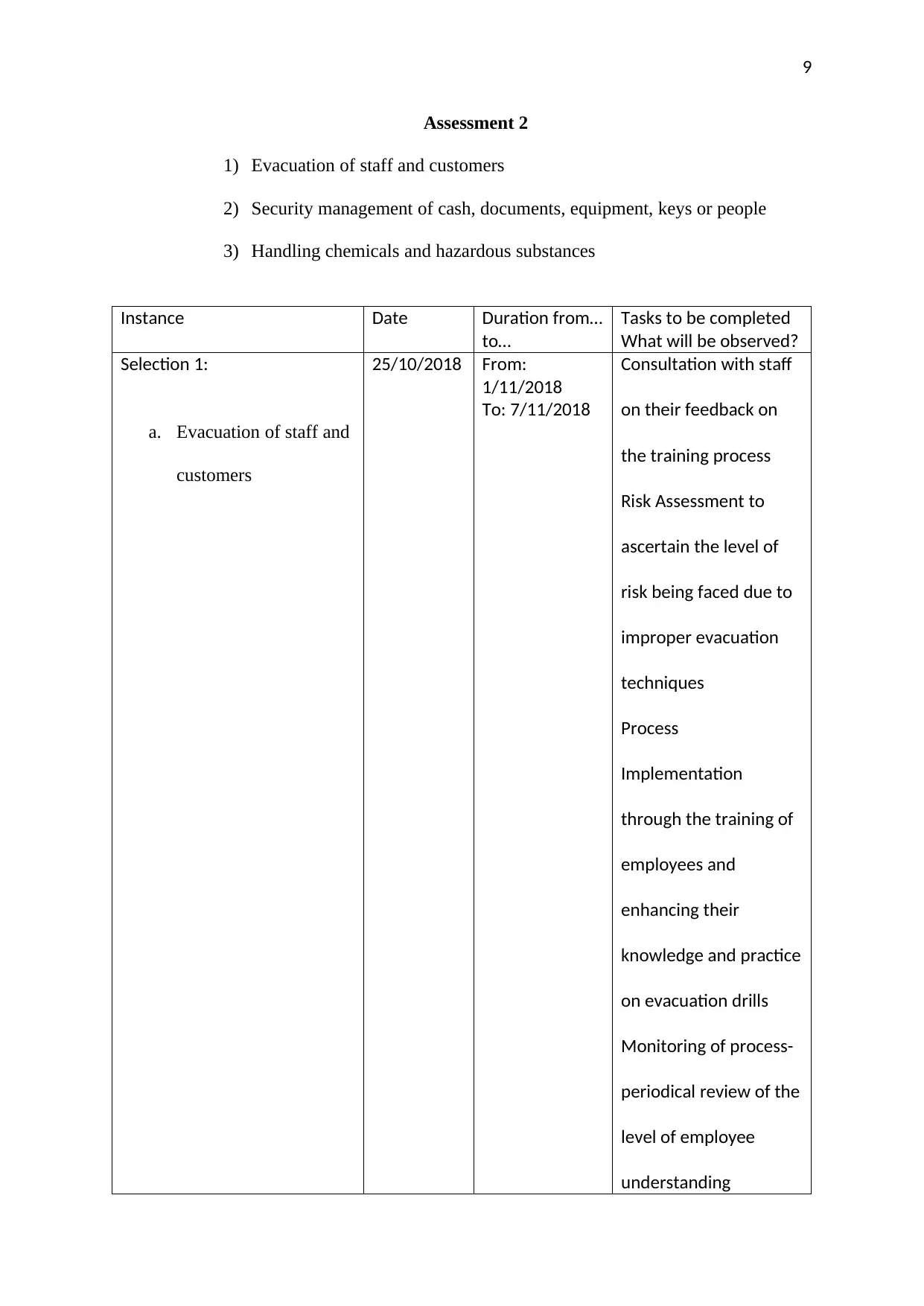
9
Assessment 2
1) Evacuation of staff and customers
2) Security management of cash, documents, equipment, keys or people
3) Handling chemicals and hazardous substances
Instance Date Duration from…
to…
Tasks to be completed
What will be observed?
Selection 1:
a. Evacuation of staff and
customers
25/10/2018 From:
1/11/2018
To: 7/11/2018
Consultation with staff
on their feedback on
the training process
Risk Assessment to
ascertain the level of
risk being faced due to
improper evacuation
techniques
Process
Implementation
through the training of
employees and
enhancing their
knowledge and practice
on evacuation drills
Monitoring of process-
periodical review of the
level of employee
understanding
Assessment 2
1) Evacuation of staff and customers
2) Security management of cash, documents, equipment, keys or people
3) Handling chemicals and hazardous substances
Instance Date Duration from…
to…
Tasks to be completed
What will be observed?
Selection 1:
a. Evacuation of staff and
customers
25/10/2018 From:
1/11/2018
To: 7/11/2018
Consultation with staff
on their feedback on
the training process
Risk Assessment to
ascertain the level of
risk being faced due to
improper evacuation
techniques
Process
Implementation
through the training of
employees and
enhancing their
knowledge and practice
on evacuation drills
Monitoring of process-
periodical review of the
level of employee
understanding
⊘ This is a preview!⊘
Do you want full access?
Subscribe today to unlock all pages.

Trusted by 1+ million students worldwide
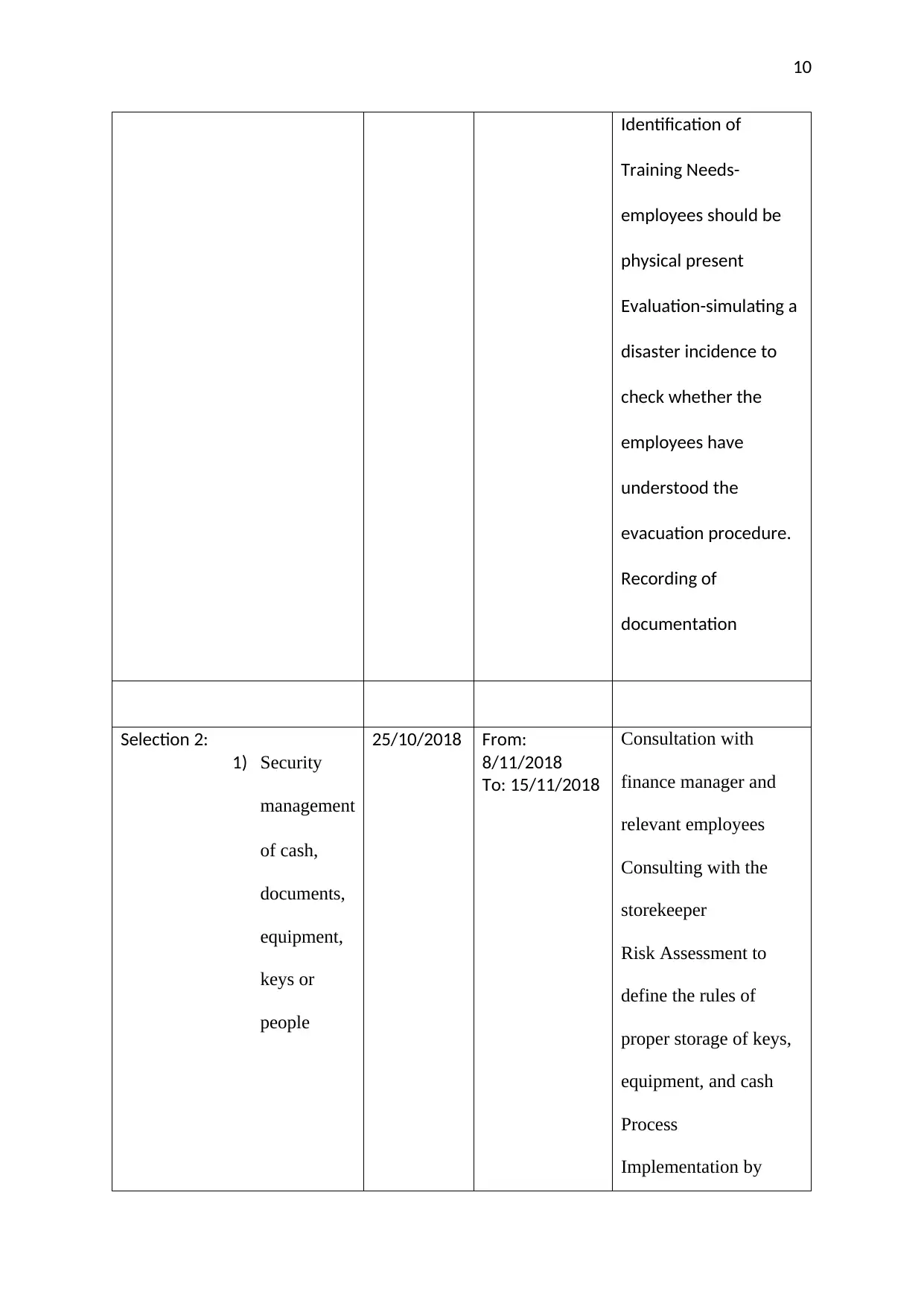
10
Identification of
Training Needs-
employees should be
physical present
Evaluation-simulating a
disaster incidence to
check whether the
employees have
understood the
evacuation procedure.
Recording of
documentation
Selection 2:
1) Security
management
of cash,
documents,
equipment,
keys or
people
25/10/2018 From:
8/11/2018
To: 15/11/2018
Consultation with
finance manager and
relevant employees
Consulting with the
storekeeper
Risk Assessment to
define the rules of
proper storage of keys,
equipment, and cash
Process
Implementation by
Identification of
Training Needs-
employees should be
physical present
Evaluation-simulating a
disaster incidence to
check whether the
employees have
understood the
evacuation procedure.
Recording of
documentation
Selection 2:
1) Security
management
of cash,
documents,
equipment,
keys or
people
25/10/2018 From:
8/11/2018
To: 15/11/2018
Consultation with
finance manager and
relevant employees
Consulting with the
storekeeper
Risk Assessment to
define the rules of
proper storage of keys,
equipment, and cash
Process
Implementation by
Paraphrase This Document
Need a fresh take? Get an instant paraphrase of this document with our AI Paraphraser
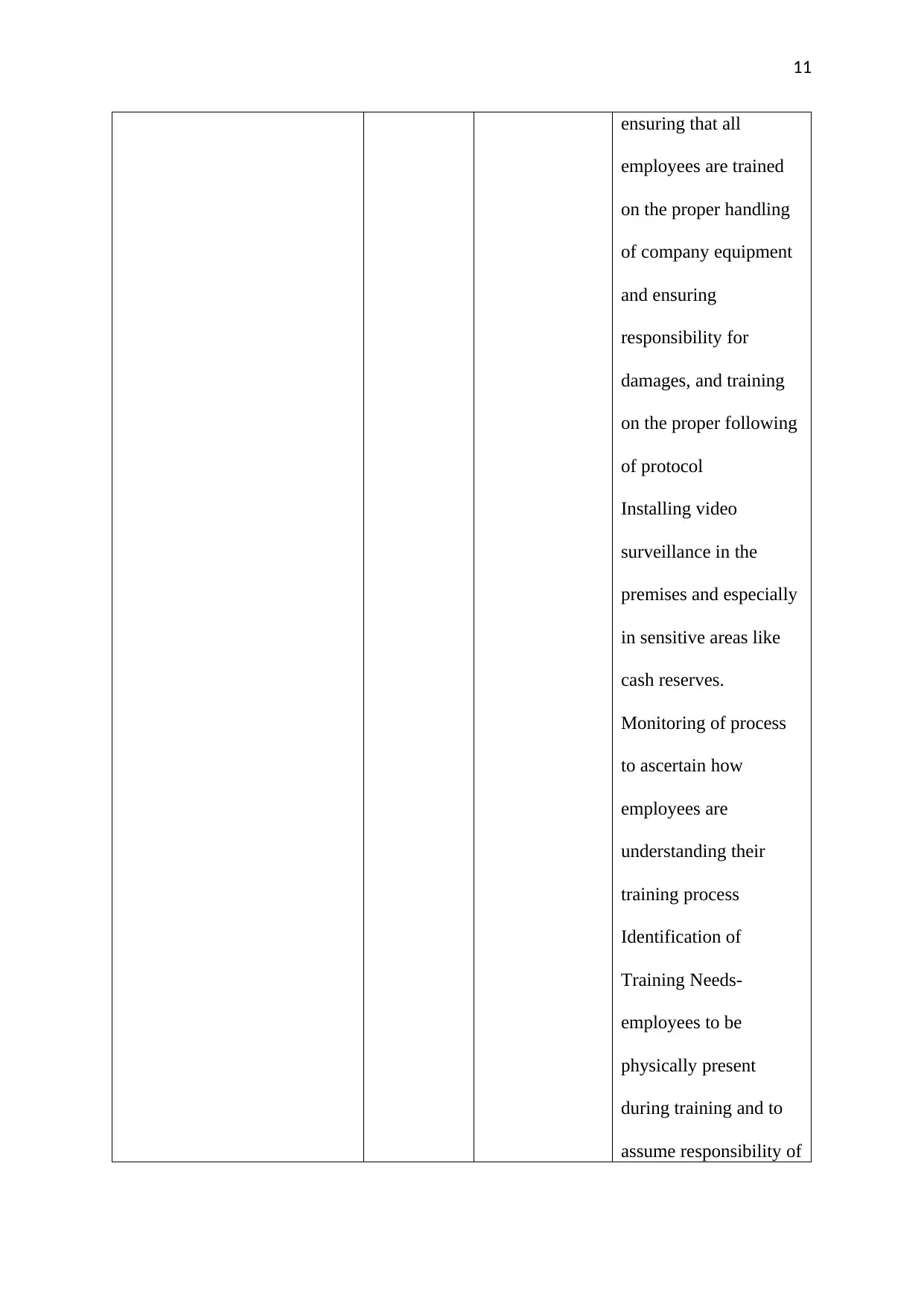
11
ensuring that all
employees are trained
on the proper handling
of company equipment
and ensuring
responsibility for
damages, and training
on the proper following
of protocol
Installing video
surveillance in the
premises and especially
in sensitive areas like
cash reserves.
Monitoring of process
to ascertain how
employees are
understanding their
training process
Identification of
Training Needs-
employees to be
physically present
during training and to
assume responsibility of
ensuring that all
employees are trained
on the proper handling
of company equipment
and ensuring
responsibility for
damages, and training
on the proper following
of protocol
Installing video
surveillance in the
premises and especially
in sensitive areas like
cash reserves.
Monitoring of process
to ascertain how
employees are
understanding their
training process
Identification of
Training Needs-
employees to be
physically present
during training and to
assume responsibility of
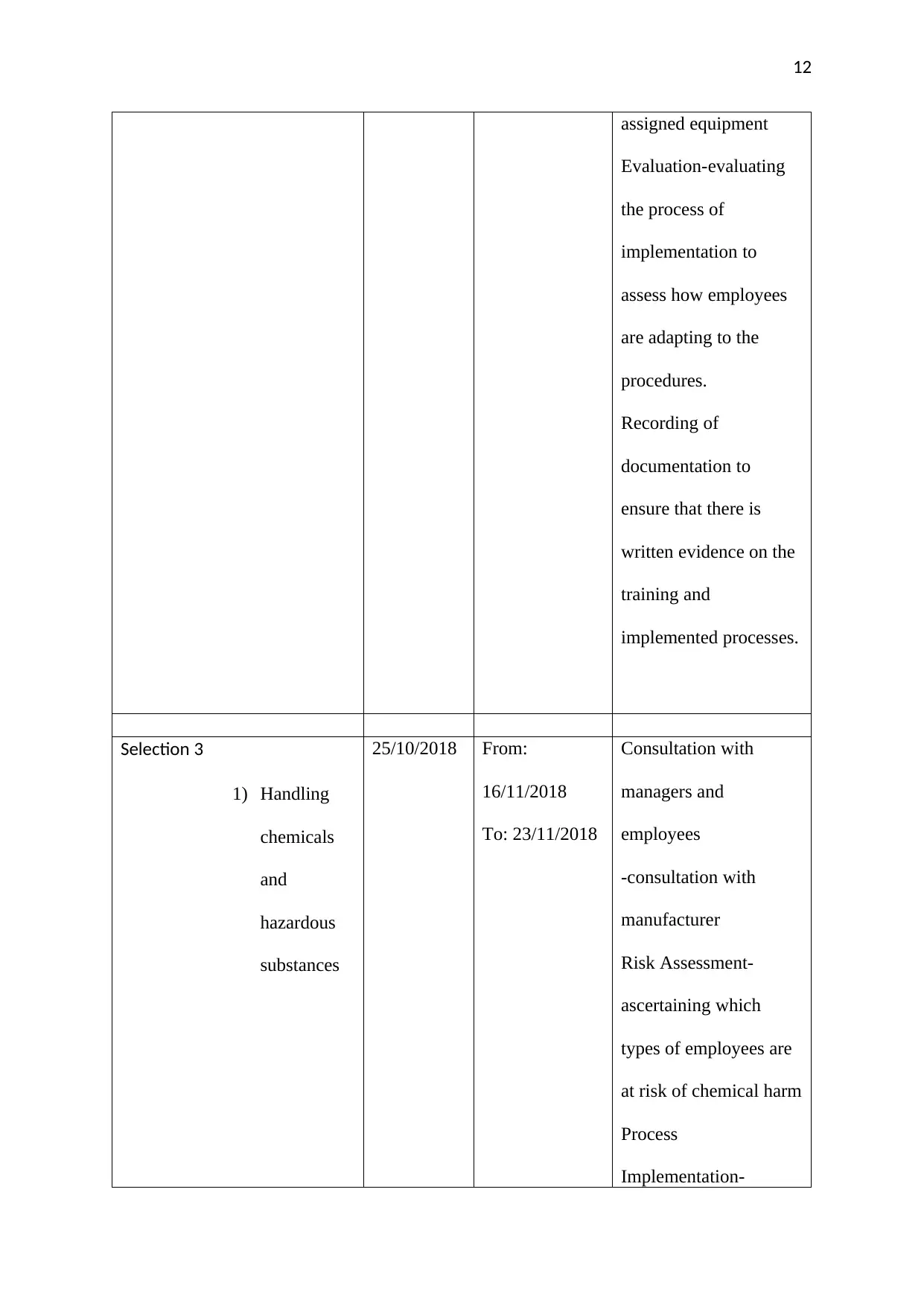
12
assigned equipment
Evaluation-evaluating
the process of
implementation to
assess how employees
are adapting to the
procedures.
Recording of
documentation to
ensure that there is
written evidence on the
training and
implemented processes.
Selection 3
1) Handling
chemicals
and
hazardous
substances
25/10/2018 From:
16/11/2018
To: 23/11/2018
Consultation with
managers and
employees
-consultation with
manufacturer
Risk Assessment-
ascertaining which
types of employees are
at risk of chemical harm
Process
Implementation-
assigned equipment
Evaluation-evaluating
the process of
implementation to
assess how employees
are adapting to the
procedures.
Recording of
documentation to
ensure that there is
written evidence on the
training and
implemented processes.
Selection 3
1) Handling
chemicals
and
hazardous
substances
25/10/2018 From:
16/11/2018
To: 23/11/2018
Consultation with
managers and
employees
-consultation with
manufacturer
Risk Assessment-
ascertaining which
types of employees are
at risk of chemical harm
Process
Implementation-
⊘ This is a preview!⊘
Do you want full access?
Subscribe today to unlock all pages.

Trusted by 1+ million students worldwide
1 out of 27
Related Documents
Your All-in-One AI-Powered Toolkit for Academic Success.
+13062052269
info@desklib.com
Available 24*7 on WhatsApp / Email
![[object Object]](/_next/static/media/star-bottom.7253800d.svg)
Unlock your academic potential
Copyright © 2020–2025 A2Z Services. All Rights Reserved. Developed and managed by ZUCOL.





